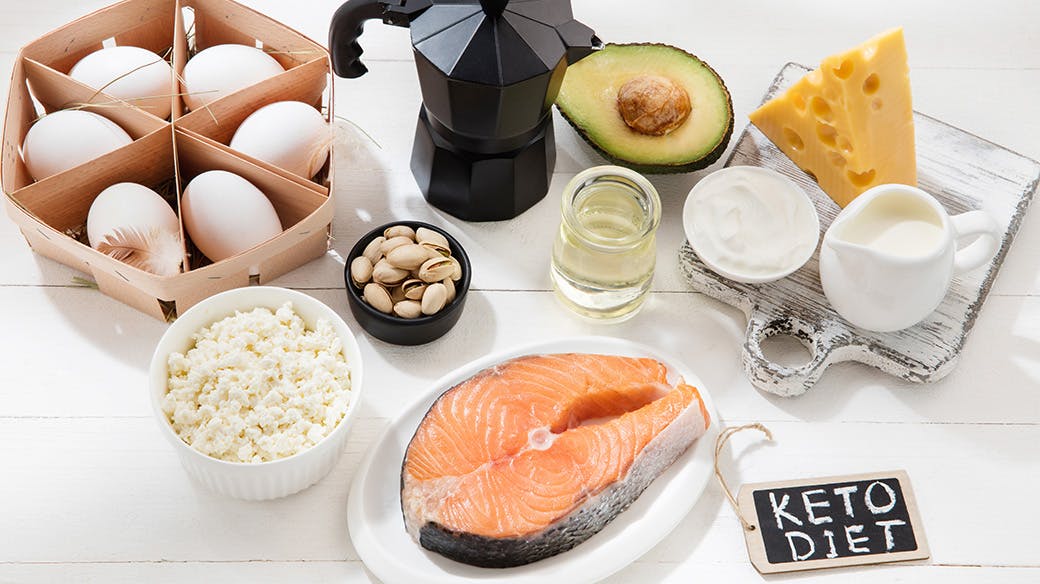The generally accepted way to lose weight used to be moderating the amount of fat consumed and reducing existing fat by increasing energy metabolism. Nowadays, however, there’s a movement towards the paradoxical concept of losing fat by eating fat. It’s known as the Ketogenic Diet, or 'keto'. If you’re looking to shed some fat yourself and lose weight, you’ll want to know more about keto, so here goes.
The facts about the Ketogenic Diet
The catchy slogan ‘eat fat to lose fat’ heralded the arrival of the Ketogenic Diet on the scene. Nevertheless, this doesn’t tell you that “keto” not only focuses on fat but also protein and while sharply reducing starch and sugar intake as well. But let’s be clear; the fats we’re talking about are the natural, healthy kinds. In other words, they’re unsaturated fats such as olive oil, rice bran oil, avocado, butter, cheese, sea fish, and nuts like almonds, pistachios, and walnuts, among others.
The body turns to burning accumulated fat only after it has used up its carbohydrate intake and that is also when it starts generating Ketone Bodies. That’s good: in what’s called the “ketosis process” energy from ketone fuels the brain and other essential organs and keeps them running until the next load of carbohydrates. The process is commonly triggered after 2-4 days of restricted carbohydrate intake.
There are four types of the Ketogenic Diet as follows:
· Standard Ketogenic Diet focuses on minimizing carbohydrate consumption while adding fat and protein. Carbohydrate is usually set at 5% of the total diet while protein and fat are set at 20% and 75% respectively.
· High-Protein Ketogenic Diet is similar to the Standard Ketogenic Diet but with more protein content. Carbohydrate is set at 5%, protein at 35%, and fat at 60%.
· Cyclical Ketogenic Diet involves regular interludes of fasting or refraining from eating. The Ketogenic Diet advocates fasting four days, followed by three days of normal diet and repeat.
· Targeted Ketogenic Diet focuses on carbohydrate intake during exercise. It recommends consuming around 15 grams of carbohydrate 20-30 minutes prior to every exercise session and applying the Standard Ketogenic Diet at other times.
Why is keto good for you?
The health benefits that have made keto so popular revolve around helping make losing weight easy. When the body primarily receives fat and protein, over the long haul you feel full for longer and have less appetite overall. As such, people on keto diets are able to limit their energy intake which also plays an important role in helping lose weight. In addition, research has shown that the Ketogenic Diet may be beneficial in reducing the risk of diabetes, helping control epilepsy symptoms, and reducing the risk of heart disease, cancer, Alzheimer's, Parkinson's, and other medical conditions. More research is needed to confirm these findings.
Who are good candidates for the Ketogenic Diet? And who aren’t?
The Ketogenic Diet is undeniably a valuable tool for those who are overweight, those who want to restore appropriate rates, and diabetics. It may also help relieve difficult epilepsy symptoms. Conversely, keto isn’t such a great idea for athletes and those who want to gain muscle mass or put on weight because they’re too skinny. In these cases, keto may actually be harmful even to the point of being dangerous. Nor is it suitable for diabetics who take glucose level lowering drugs. This is because the diet can lead to low blood sugar as the body doesn’t get enough carbohydrates to process into sugars. Moreover, the Ketogenic Diet isn’t suitable for diabetics who need insulin because it generates more ketones that make the blood acidic. Last but not least, those with renal impairment should steer clear of keto because in such cases eating too much protein can lead to kidney failure. So, if you’re thinking of going on a keto diet but have certain health issues, it’s best to consult your doctor first.
Side effects
Although potentially beneficial to the body in many ways, keto can have side effects in different people and cases. For instance, keto flu; nutrient, water and mineral deficiencies; frequent thirst; constipation; body fatigue; brain fatigue; acne; oily skin; irregular menstruation; high cholesterol; difficulty sleeping, and decreased bone mass. Another factor to consider is the yo-yo effect feared by some people whereby you put back on all the fat you lost on the diet once you stop it. As such, it is always a good idea to study up on all the angles before taking the keto plunge.
On the other hand, if you are looking to lose weight effectively and quickly and don’t have any of the aforementioned health problems, keto could fit the bill nicely, especially for say six months. Don’t go on with it too long because it may deprive the body of certain nutrients in sufficient amounts.
Last not least, the Ketogenic Diet is most effective in conjunction with exercise. Not only does exercise increase metabolism and fat-burn but it also helps avoid that yo-yo issue.
Krungthai-AXA Life Insurance customers who are interested in health care can read other health articles at: https://www.krungthai-axa.co.th/th/health-advisories.
References
· Bangkok Hospital
https://bit.ly/3NmOB9k
· Corporate Communication, Faculty of Medicine, Ramathibodi Hospital
https://bit.ly/3OLWmqr
· King Chulalongkorn Memorial Hospital, the Thai Red Cross Society
https://bit.ly/3A4YLIw
· Chulalongkorn University
https://www.chula.ac.th/highlight/67885/
· Pobpad website
https://bit.ly/3Oikscp
· Ketogenic
https://ketogenic.com/targeted-ketogenic-diet/


